Intro to small business websites
In today’s day and age, it’s a must to have a website for your small business. Gone are the days when you could add your business info to the Yellowpages and see the calls roll in. Now, people expect to find information about businesses online, and if they can’t find you right away, chances are, they’re never going to become a customer.
Your small business website is your online storefront—and it’s crucial to not only have a website but to have a great one.
But what does it take to build a great small business website, how can you use your website to get more customers, and how do you know it’s actually working?
Lucky for you, we’re going to answer all those questions and more in this handy course! You’ll learn:
- Why you need a small business website
- What elements your website needs
- How to get leads from your website
- The best small business websites examples
- Options for building a small business website
- How to measure website performance
- Steps for a basic small business website audit
We’ve got a lot to cover, so let’s dive right in!
Benefits of having a small business website
So, why do you really need a business website? We’ve got five reasons for you here:
1. It’s the hub for your business
Your small business website is the one place on the internet that’s truly all about you. Sure, you can (and should!) create profiles on social media or manage your business on local listings sites, but none of these sites paint a complete picture of your business.
Even a site like Facebook, where you can build out a pretty complete profile, is not a substitute for your own website.
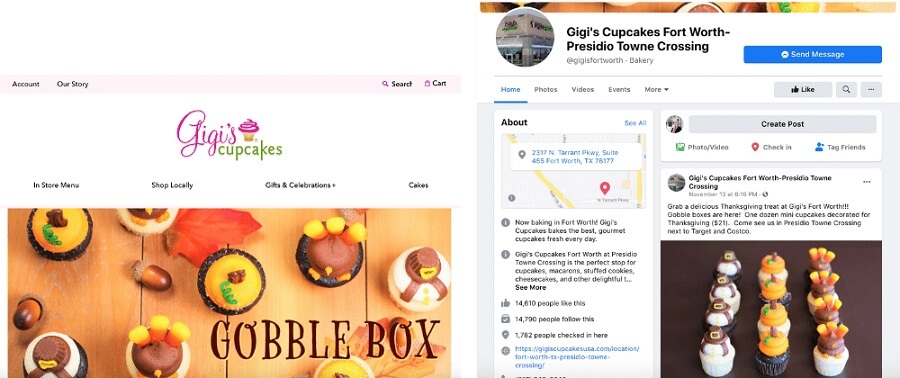
Here’s an example of a business’s website vs. their Facebook page. You can get a better sense of their business and learn more about them from their website.
As you can see from the example, you can’t fully brand your page on another site–even Facebook. When you’re on another platform, the formatting and layout are dictated to you by the site. When you create your own website, all of the colors, images, and content are about you. Plus, you can organize and arrange information, images, and video to tell your story in the most impactful way possible.
But, maybe most importantly, creating your own small business website gives you ownership over your online presence, your content, your images, and your branding. You’re not at the whim of the social media platform–you’re in control!
(Speaking of branding your website…find out how to write the best business description!)
2. It’s the foundation for all your marketing
Because having your own small business website allows you total control over how you tell your story, it becomes the basis for all your other marketing efforts online. The ads you create, the social media profiles you establish, and the local listings you manage should all drive users back to your website. And what you have on your website will shape the way you share information through each of these other marketing channels.
For example, let’s say you want to start a local PPC campaign to draw attention to your new product launch. Without a website, there’s nowhere for you to send people who click on your ad!

With a comprehensive site, however, you can build a customized and high-converting landing page specifically for searchers who click on that ad. The page can highlight all the features of the new product and allow your audience to get on the waitlist.
3. It helps you track and capture leads
There are hundreds of ways for consumers to find out about your business these days. They might find you through your marketing efforts on various channels, or they may happen upon your business’s name in a blog post from an influencer who’s recommending your brand.
No matter where they find out about you, though, you want all roads to lead to your small business website. Driving traffic to a centralized location gives you a greater chance of capturing information about your prospects and customers and keeping it in one place, like your CRM. Your website can also help you collect first-party data, which is increasingly important with Apple’s iOS 14 update and Google’s announcement that it will no longer track third-party cookies beginning in 2023.
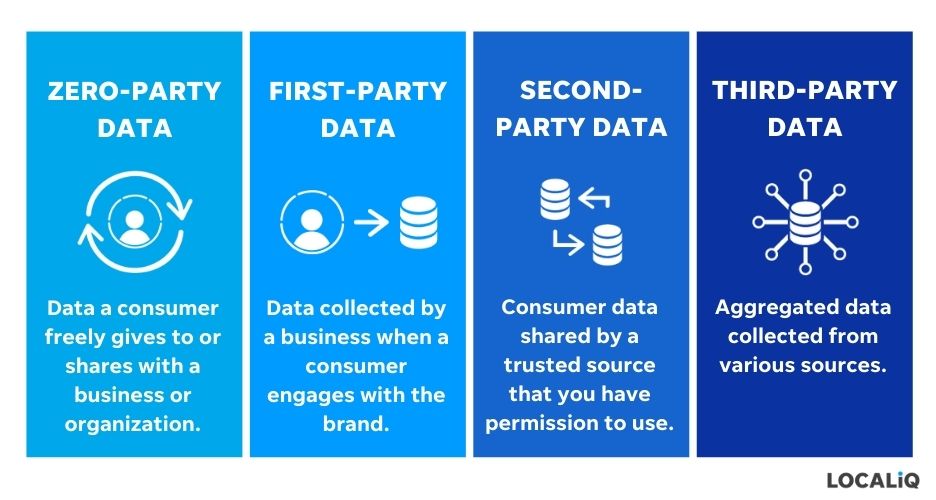
By tracking website visits, you can also begin to see patterns emerge that can inform your marketing strategy. Is there one marketing channel that seems to generate a lot of traffic? Maybe it’s time to focus more attention and spend on that avenue.
4. It puts you in the driver’s seat on the customer journey
When you’re creating a path from discovery to first purchase for your customers, you need to tell them what you expect them to do along the way. Maybe you create an ad campaign to drive awareness, have some introductory promotions to guide them through the sales funnel, and are hoping this all leads to an eventual purchase once the consumer is able to try your product. But if you don’t make that path clear, they won’t know to follow it!

When you drive traffic to your website, you have the power to greet them with calls to action that initiate conversions and start visitors down the sales funnel towards making a purchase.
Without a proper website in place, you don’t have the power to guide the customer journey and instead are left hoping that they find a path to conversion on their own.
5. It can help you stand out from the competition
While a website is a must in today’s digital world, the fact is that not all small businesses have invested in one. Your small business website can help you stand out from other growing businesses that either don’t have a website or don’t have a website that’s user-friendly or enticing.
A well-designed website that clearly showcases your products or services, your unique brand story, and works to establish your business as an authority in your industry can help you win over customers and stand out from your local competitors.
Small business website checklist
Your business website should be the most reliable source of information for consumers. If in doubt or looking to find more information, customers will check your website. Use this handy checklist to ensure your website has everything local customers expect to find.

1. Mobile-friendly or responsive design
Over half of all searches are conducted on mobile devices, meaning if your site isn’t optimized for mobile, you’re not delivering a good experience for your website visitors.
Additionally, in 2020, Google announced mobile-first indexing for all sites, meaning they base search result performance on mobile, not desktop, websites. This means that if you don’t have a mobile-friendly site, you may not rank at all on Google, which means fewer people will find and visit your website.
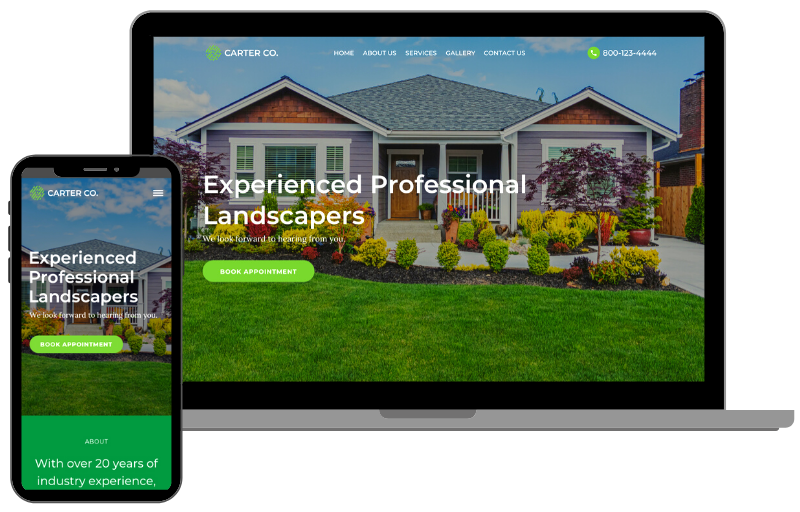
An example of a responsive website design.
Make sure your small business website is functional and looks great across all devices and screen sizes,
2. Address and directions
Make it easy for your website visitors to find your address and directions. You should include this on your Contact Us page, but your address can also be present across your site in your footer. You should also embed a map so customers can easily get directions to your business (plus it helps with local SEO!).
3. Hours of operation
Don’t hide your hours of operation. It’s best not to risk customers coming to your business to find closed doors.
42% of consumers say not finding hours leaves a negative impression.
4. Contact information
Your phone number must be front and center on your website across every page. More than 50% of consumers will view your site right from their phones! If you accept text messaging, be sure to mention this. Younger consumers prefer text messaging over phone calls. It’s also helpful to include your business’s email address so customers can email you directly from your site.

This business has its contact information prominently displayed in multiple places across the site.
5. Product or service information
Nearly 80% of consumers say they visit the website of a small business to find product and service info before physically visiting a business. Describe your business, what you’re offering, and how your business is unique. Think of your website as your online storefront. Make it easy for visitors to understand what your business is all about.
6. Menu
If you run a restaurant or eatery, post a menu on your website. Consumers don’t want to go to any extra effort to find the content they’re used to seeing on your competitors’ websites. And today it’s easier than ever to add your menu to your website or to simply add a link to a third-party site that hosts your menu.
Related: Get a website accessibility checklist here.
7. Photos
Since pictures speak louder than words, photos of your business are crucial to winning customers. Photos convey the atmosphere of your business and give browsing consumers an idea of what to expect. In fact, 58% of consumers say they have left a business’s website if they can’t find photos or a video on the website.
Add 4-5 key images showing your place of business, products and services, happy and satisfied customers, and staff working with customers.

This business included a gallery of their completed work on their website.
8. About Us page
Your small business website is the best place to tell your story. An “About Us” page is your chance to let consumers know why you went into business and why you love what you do. Your story and personal connection to your business set you apart from big box stores and chains.
Related: Get About Us page examples and tips here.
9. Links to social media pages
Most of the activity for your business probably lives on your social pages. Adding links to your social media pages lets your website visitors dig even deeper and get the level of comfort necessary to becoming new customers.
10. Qualifications and awards
Important qualifications, accreditations, certifications, memberships, or awards help build confidence and trust in your business. Don’t be shy, and include these on your website to turn visitors into customers. You worked hard to earn them! These are unbiased and help build confidence and trust in your business.

This business has a news section on its site that calls out its accolades.
11. Testimonials
If you run a service-based business, be sure to add testimonials to your small business website. Prospective customers love to read stories from other people. Plus, testimonials confirm whether the business or service will meet their needs.
12. Positive customer reviews
Take pride in your good reviews from sites like Google, Yelp and Facebook and put them on display on your website! Positive reviews prove to potential customers that you run a great business.
13. Local keywords
If you don’t optimize your website for search engines using SEO, you’ll have a much harder chance of getting found. One way to optimize your website for SEO is to incorporate local keywords into your web content. This means identifying the right local keywords and adding them naturally into your content on places like your homepage, services or products pages, and your About Us page to clearly communicate to both search engines and visitors what your business is focused on.
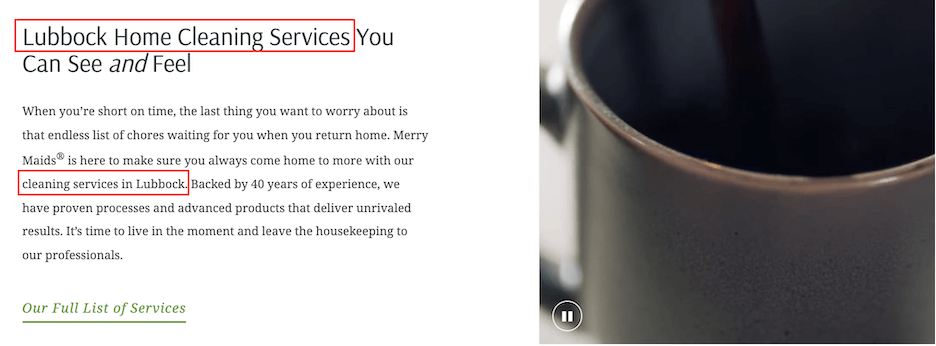
Get our guide on how to do local keyword research here.
14. The latest information
Finally, remember to keep your website updated. Customers lose confidence and interest when visiting a site with outdated information. This means no outdated offers or promotions, seasonally-appropriate images and events, and anything important happening with your business in the upcoming weeks and months.
Related: Get more website copywriting tips.
How to get leads from your website
Your website is more than just a place for people to learn about your business. It’s also a valuable lead generation tool that can help you capture and convert more prospects into customers.
Here are some ways to get leads from your website.
Add a contact form
One of the best ways to capture leads from your small business website is to include a contact form.

You can easily set these up and have the information routed to a lead inbox. From there, you can follow up, mark a status, or funnel the new contacts into a lead nurture program where they’ll receive a series of emails until they take a desired action.
Related: Get small business email templates and examples to make lead nurture a breeze.
Enable click-to-call for your mobile site
One very simple way to collect leads from your website is to enable click-to-call on the mobile version of your website. This simply allows users to call you by clicking your number on your site. This removes any extra steps it takes to contact you.
Use call tracking technology
Click-to-call is great, but if you can’t tell that your calls are coming from your website, it makes it hard to track success. That’s where a call tracking technology comes in. With call tracking technology, your phone number adjusts based on how someone navigated to your website—this allows you to understand how leads are finding you and taking that next step to become a customer.
And this works even better with call recording. Call recording will allow you to listen to the calls that came in from your website so you can keep track of the conversations and make any necessary call handling improvements for yourself or your team.
Use live chat
Website chat is an extremely valuable lead collection tool you can use on your site. Customers actually prefer live chat over any other type of communication with a business because it allows them to get quick answers to questions without needing to call or wait for an email response. Live chat also allows you to collect lead information at any time—whether your business is open or closed.

Include booking and ordering options
Another way to use your website to generate leads for your business is by including booking or ordering options directly on your site. This allows customers to book appointments at any time. Over a third of consumers prefer to book appointments in off-hours, so this is crucial. If you run a restaurant, consider adding online ordering to let customers place orders without being put on hold.
Best small business website examples (+why they work!)
Now that we’ve talked about what your website needs to include and how you can use it to collect leads, let’s look at some examples of the best small business websites.
Dentist website example: Sandpiper Dental
Sandpiper Dental is a family-friendly dental office in Minnesota. We know that because they very clearly outline it on the homepage of their website.
This small business website example has a lot going for it: The website clearly outlines Sandpiper’s top services through both a dropdown in their navigation bar as well as by calling them out on the homepage.

This dentist website also gives patients the opportunity to book an appointment directly through the site or via click-to-call.
Another great addition to this website is the “smile gallery,” which shows before and after photos of patients’ teeth after working with Sandpiper. This adds great social proof and could help sway potential patients to give them a call.
They also have a badge that prompts patients to review them on Google, which can help them collect more reviews, which will be helpful for getting new patients.

Real estate website example: Realty 1st
Realty 1st helps home buyers and sellers in the Atlanta area. One thing that immediately sticks out from this website example is the presence of live chat. This gives prospective clients an easy way to connect with the business—while also giving this real estate agency a simple way to collect lead information.

Another great addition to this real estate website is this section outlining what sets them apart from competitors. This section helps to add credibility and authority and can also help sway potential clients to contact this agent over others in the area.
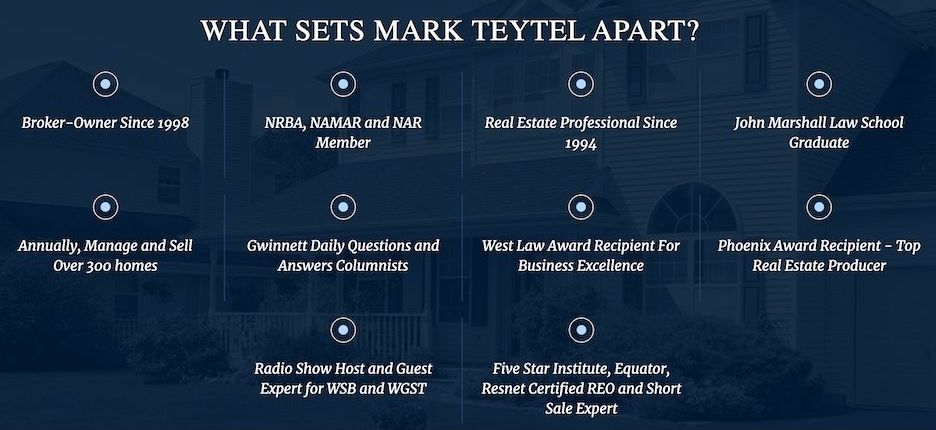
This real estate agency is also building authority and credibility on their website with their blog. Their blog has content related to buying and selling homes to position the business as a resource and provide clients and potential clients with helpful information. Their blog can also boost their local real estate SEO by focusing on keywords that will help them rank for relevant local searches.
Home services website example: Parley’s PPM Plumbing
Parley’s PPM Plumbing, Heating & Cooling has a lot going on their website to help customers get help with their plumbing or learn more about what may be causing their problems.

For one, they have a contact form right on the homepage of the website to help expedite getting in touch with the business to address a specific plumbing problem.
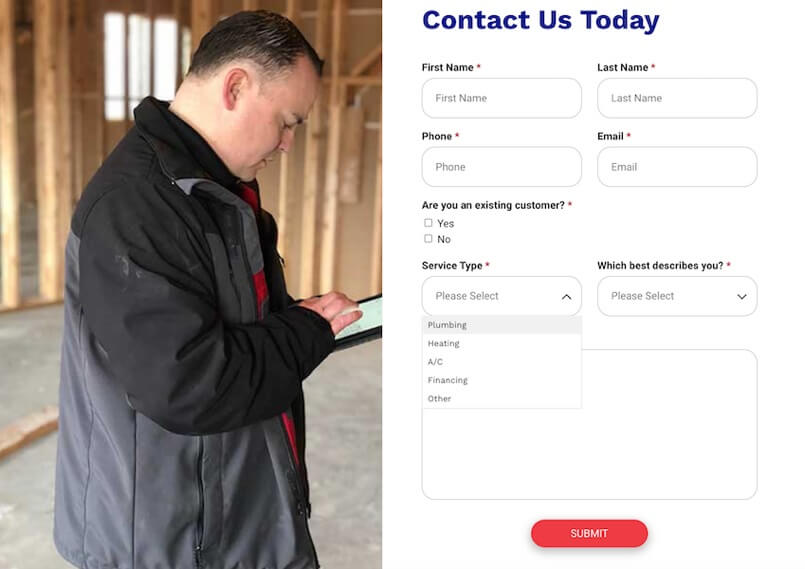
Parley’s PPM also created FAQ pages for its services to address commonly asked questions that can help inform their customers while also building trust in their business.
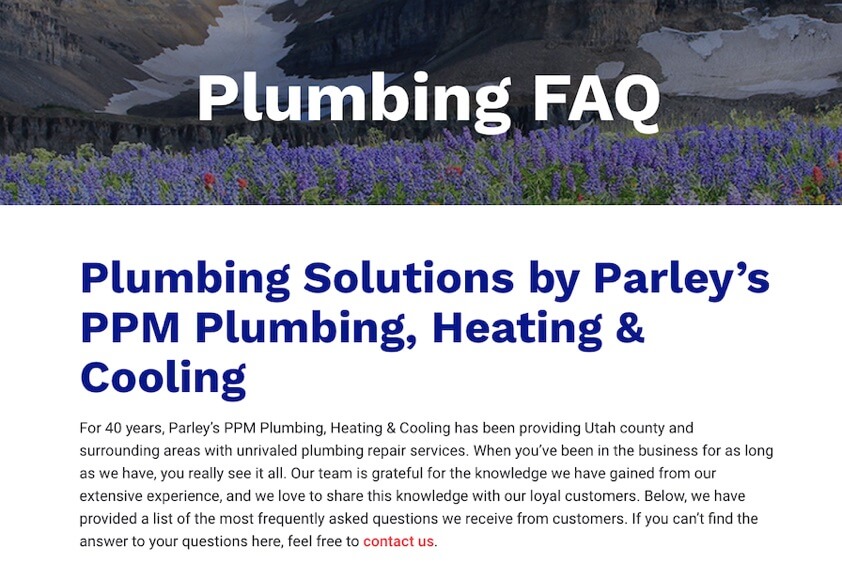
They also feature Google reviews directly on their site to build even more trust and showcase what others have said about their services. This is especially helpful for service-based businesses because you want your customers to trust you and your team to do a good job.

Education website example: Mount Hope Christian School
What’s not to love about this education website? Mount Hope Christian School uses a colorful design that draws users in with a strong call to action that urges them to take a virtual tour.

They have a very easy-to-navigate website that gives parents the option to learn more about the school, its programs, what it teaches, and more.
They also have quick links at the top of every page on their site to allow for new student enrollment, which can help drive even more leads.
Another element we love about Mount Hope’s website is their About Us page, which provides a lot of helpful information that can help the school connect with parents of prospective students.

Automotive website example: Don the Car Care Man
People love working with local businesses—especially those that have been serving their communities for years. Don the Car Care Man leads with this information on its small business website, letting users know they’ve been in business for the last 50 years.

Another thing customers love? Coupons! And Don the Car Care Man has a whole section on their site for coupons. This is a great way to drive more clicks around your website and sway people to take the next step to become your customer.

This small business website is also very easy to navigate, has contact information prominently displayed throughout the site, and is organized in a way that users can find out what services they provide with ease.
Multi-location business website example: The Smoothie Bus
Multi-location businesses have it a little harder when it comes to creating the best small business website. They have to create a website that is optimized for all of their locations so potential customers can find the information most relevant to them.
The Smoothie Bus does a great job of this on its small business website, clearly calling out it’s locations and allowing users to place an order directly on the site for any of the locations listed.

It’s also very important for multi-location businesses to create and include a Locations page or dropdown so website visitors can easily find information about the location closest to them. This business uses a dropdown that leads to individual location pages.
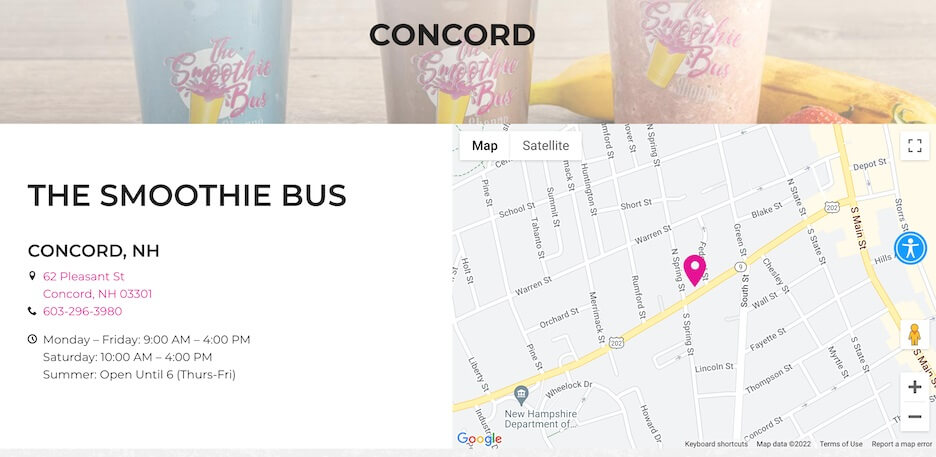
These location pages can also help with multi-location SEO so your business has a higher chance of ranking for location-based searches.
Retail website example: Showman Furniture
Creating the right small business website is extremely important for retail businesses. Because you’re selling a product, you need your website to show off that product and entice users to either place an order right there or visit your business to make a purchase.
Showman Furniture is a great small business website example because they clearly break out their product types and include high-quality images that show off what they have to offer.

They also provide helpful information on their small business blog that can help position them as a trusted resource when it comes to shopping for furniture.
They also offer a low-price guarantee that’s listed across the site, which can help entice website visitors to take the next step and become a customer.

Learning from the best small business website examples can help you as you design your own website. Find websites from businesses (both large and small) that you like and see if there are any features you want to add to your own site.
How to make a website for a small business
When it comes to creating your small business website. You have some options. Let’s explore what they are and the pros and cons of each.
Do-it-yourself websites
One option when it comes to creating your small business website is to build and create it yourself. This is typically done through a website builder where you can choose a template and make customizations from there.

Pros:
When you build a website yourself, you have the most control because it all comes down to you. This means you can make updates and customizations to the site—typically within the confines of the template you choose—so it looks to your liking.
Building your website yourself can also be a cheaper option because you’re paying for a specific plan through the site builder as well as the cost of your domain.
Cons:
Of course, the flip side of this is that you’re solely responsible for building, updating, and maintaining the website. While many website builders try to make it as easy as possible, it will still take some learning to figure out how to use the program, set up the site the way you want it to look, and understand the backend of what you’re creating.
Another con is that many website builders aren’t fully optimized for SEO as SEO and web design go hand-in-hand. This can lead to headaches down the line if your site isn’t performing well.
Not to mention, if your website goes down for some reason, you have limited options to get it back up unless you’re a pro developer. This can lead to lost customers and a lot of stress.
Independent website developer
Another option for building a website is to work with an independent website developer. This would entail hiring someone who specializes in web development either as a freelancer or who owns their own agency or business.
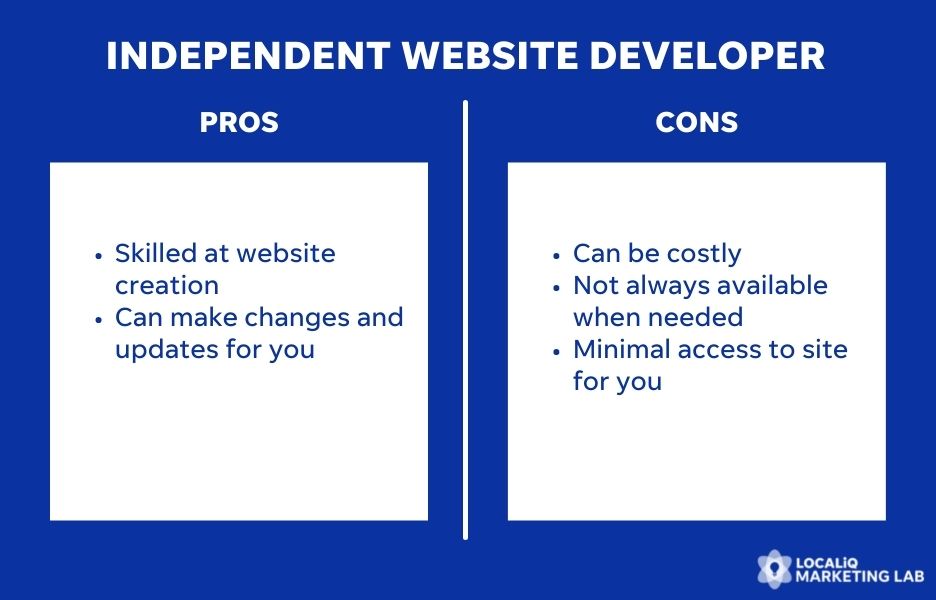
Pros:
Web developers are obviously pros at creating websites, so they can help you set up your site to your liking and make the necessary optimizations. They also act as support in making updates and maintaining your site so you don’t have to be on the hook for any of those functions.
Cons:
When you’re working with an independent website developer, you typically pay either an hourly rate or a flat rate that includes a set amount of support per month. This means that if you need updates or changes made, it will go toward your hours of support. This can get costly quickly.
In addition, depending on how many clients your developer has, you may not get support or updates made as quickly as you’d like, and you may not have access to your site to make the changes yourself at all.
Website design company or marketing platform
Another option for your small business website is to work with a website design company or a marketing platform to create the site for you.

Pros:
Working with expert marketers to create your small business website is one of the best options for your website. These organizations know what works, are industry experts, and can provide tools and technology that can tie your other marketing efforts together. A larger company also means more access to support and tools to help keep your website updated and optimized.
Cons:
Working with a marketing platform for your website gives you less control than when you build a website yourself because it’s fully built through your partner. Make sure to ask questions such as who owns the domain and how quickly updates and changes will be made so you have a good understanding and expectation of your partnership.
Small business website metrics to track
Once you have your website set up and running, the fun doesn’t stop there! It’s important to keep track of your website marketing metrics to understand how it’s performing and helping you reach your marketing goals.
Before you track your small business website metrics…
Before we get into the website metrics you need to know, it’s important that you have a way to track them. One of the best ways to track your website performance is to connect your website to Google Analytics.
![]()
If you’re working with a partner to build and manage your website, they can do this for you as well as provide their own tracking to help you understand performance. If you need to set up Google Analytics yourself, you’ll navigate to the website and follow the directions, which will include creating an account, setting up your website (which will include adding some code to the backend of your site), and providing information about your business.
Enabling Google Analytics allows you to view your website performance directly through the Google Analytics dashboard and drill down to better understand how your website and specific pages are performing.
Okay, now that we understand how to track performance, let’s talk about what to track.
Traffic and pageviews
Obviously, you want people to find and visit your website, which means you’ll need to measure website traffic. In Google Analytics, traffic is measured as pageviews. You’ll see two numbers: One for pageviews and one for unique pageviews.
![]()
A pageview is any visit to your website, and a unique pageview is any unique user that visited your website. That’s why this number will often be smaller—you’ll have repeat visitors to your site, but you want your unique users to grow along with traffic because it means more people are finding and visiting your site.
Time on site
Another helpful measure of your website performance is time on site.
![]()
The more time people spend on your site, the more helpful and meaningful the content is. One report found that a good benchmark for time on site is 54 seconds, so if your time on site is close to this, your site is right around average.
If you find that your time on site is lower than 54 seconds, you may need to consider rewriting your content and making sure your website is performing well (AKA loading quickly and easy to navigate).
Bounce rate
Bounce rate refers to any user who leaves your site after visiting just one page.
![]()
For example, if you conduct a search on Google for “refrigerator repair” and visit a site but decide you don’t want to learn more about them or they don’t do what you need, you would exit the site or go back to Google. This would be a bounce.
A high bounce rate could indicate that your website is either loading too slowly, your content isn’t compelling enough to entice users to take another action, or your web page doesn’t align with the intent of the search. You can reduce bounce rate by making sure your content and keywords align with search intent and that you’re linking relevant pages from your site within your content so users are able to follow a path across your site.
Website leads
As we’ve discussed, your website is a valuable source of driving leads for your business. So you want to track that you’re actually getting leads from your site. This will require lead tracking, which can be done through the use of a lead management system.
![]()
A lead management system will collect all your leads in one inbox and also let you know where they came from so you can see how your website is driving people to contact your business.
Website conversions
Once you’re able to track website leads, you’ll also want to track web conversions, which means how many of those leads became actual customers. Again, the best place to track this information is through a lead management system because it can track your leads from where you captured them through when and how they converted.

Without a lead management system, you can also use Google Analytics to help with this by setting up goals.
Understanding the best small business website metrics to track can help you stay on top of website performance and ensure you’re getting the best results from your site.
Basic website audit steps (+tools)
If you already have a small business website and you want to understand what improvements you can make, it’s best to perform a website audit. Website audits can range from extremely in-depth and technical to fairly basic.
We’ll start with the basics here.
(But if you want a more in-depth and free audit, try our website grader to get your score plus actionable areas for improvement!)
Tools for your small business website audit
Before you get started with your audit, you’ll want to make sure you have the right tools. Here are the tools you’ll need and want access to in order to easily complete your small business website audit.
- Short website audit checklist (we like this one from WordStream)
- Google Analytics
- Google’s Mobile-Friendly Test
- Google’s PageSpeed Insights
- Lead management system
- A little time!
Now, on to how to do a simple small business website audit.
Step 1: Check for mobile-friendliness
As we discussed, it’s essential that your small business website is mobile-friendly with a responsive design so it functions well across all devices.
If you’re unsure whether or not your website is mobile-friendly, Google has a handy Mobile-Friendly Test you can use. Simply navigate to the test, input your business’s URL, and get your answer!
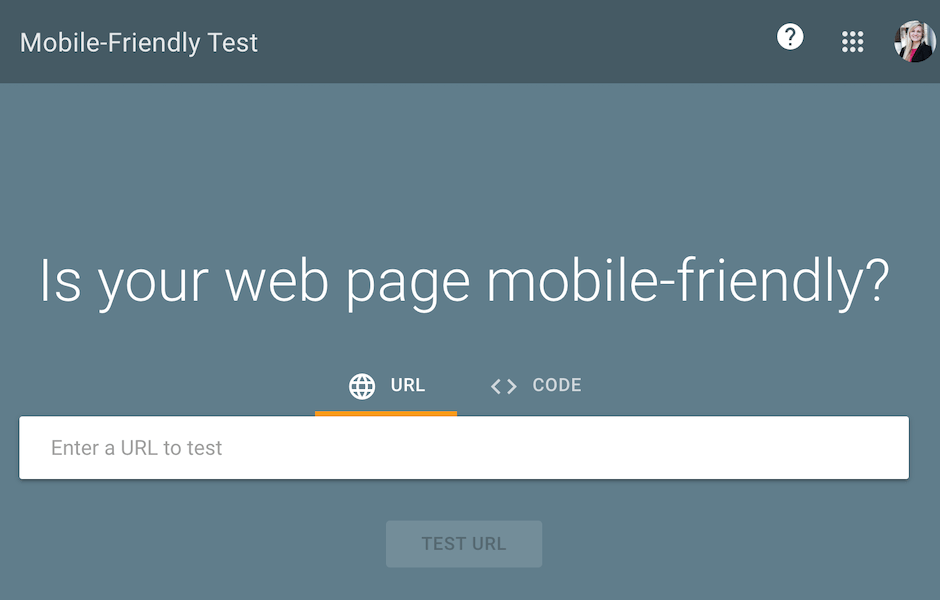
What to do: If your website isn’t mobile-friendly, it’s important to remedy this quickly. It’s crucial to the success of your website performance and your marketing. If you’re working with a developer or partner, reach out to see what they can do. If you’ve created your website yourself, see what your options are within the website builder or reach out to an expert for help.
Step 2: Check page speed
Once you know your website is mobile-friendly, it’s time to make sure it loads quickly for users. Google, again, has a helpful tool for you! PageSpeed Insights will tell you how your website is loading on desktop and mobile browsers, and it can give you a list of ways you can improve your website to make it load faster.

What to do: Try to make as many updates from Google’s recommendations as possible. This may require help from your developer or partner.
Step 3: Check for ease of navigation
When you’re conducting a small business website audit, you want to keep your users top of mind, which means ensuring your website is easy to navigate. Start with the actual website layout: Do you have a navigation bar at the top of your website? Is it intuitive how you would use that?
For example, if you have a navigation bar with additional information grouped below a main category, you may want to add a small carrot that will tell users to hover over the navigation bar to see more results.
Most small business websites have a navigation bar that includes:
- Services/Products
- About Us/Team
- Contact Us
- Testimonials
- Blog
But you can adjust those top-level navigation items based on your business type and your offerings.

This restaurant adjusted its navigation bar to include locations, catering, and employment.
It’s also important to keep your navigation bar from being too cluttered. You want to give users just enough choices to find what they’re looking for but not too many that it becomes overwhelming.
What to do: Check that your navigation bar is easy to use and easy to understand, and test your website out as a user from entry to exit—was it simple to get around and find what you needed? If not, make necessary changes and updates.
Step 4: Check your website content
The next step in your small business website audit is to read through your website content to make sure it’s easy to read, clearly conveys what it is your business does or offers, and that it incorporates the right keywords for SEO.
What to do: If you find that your website content is difficult to read, is guilty of keyword stuffing (meaning too many keywords are added in a way that’s unnatural), or that it’s unclear what your business does, it might be time for a revamp of your site content.
Step 5: Check your website for lead entry points
Because you want your website to help you collect and convert potential customers into actual customers, it’s important to survey your website to see all the various places a visitor could become a lead.
Look for:
- Contact us forms
- Click-to-call across all pages
- Address and phone number across all pages
- A contact us page
- Live chat
- Email address listed on the site

This dentist’s website includes multiple places for patients to get in contact with the practice throughout the site.
Additionally, check that you’ve included clear, strong calls to action across your site to drive users to your lead collection points.
What to do: If you don’t have any (or many) of these lead entry points, make some updates to your small business website so you can begin collecting lead information in additional ways. Add new CTAs and make updates to existing CTAs that aren’t driving the results you want.
Related: Get 50 powerful call-to-action phrases to help boost conversions.
Congratulations, small business website pro!
You did it! You’ve learned a ton about what it takes to create, manage, and optimize a small business website that helps you capture potential customers and use your site as a marketing tool to grow your business.
Want to become a pro in some other areas of local marketing? Check out our other courses: